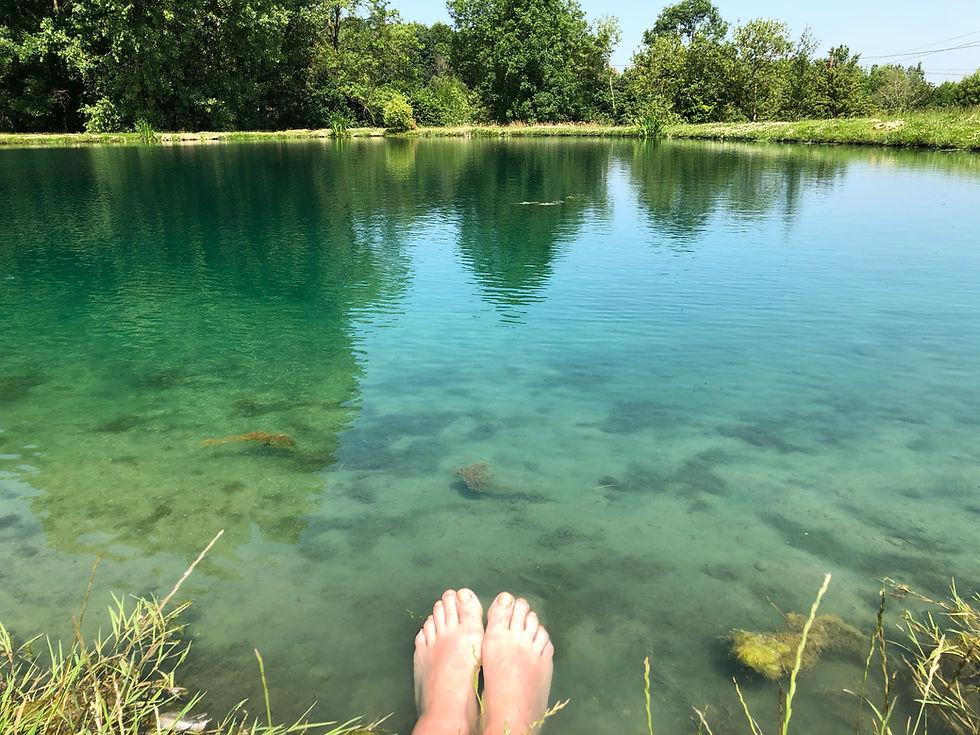A solid day's work
- Sarah Farrington

- Jul 7, 2018
- 3 min read

The concrete raft foundation was laid this week using a remote controlled 31m boom (concrete pump with a robotic arm, that's the blue tube thing in the photo!) and a continuous convoy of concrete mixers, 16 in all, to keep the concrete pouring for 8 hours.
All done in a day, I'm now the proud owner of a 250m square concrete raft foundation. However, the preparation for this week started way back in August with site investigation into what was below ground where the house will sit.

7 exploratory boreholes, going 6m below ground, discovered that the ground has a thin top gravelly layer of clay and sand above a much deep layer of sand, averaging 4m thick. The architectural design for the home is an upside-down house with all four bedrooms on the lower-ground floor, built into the sloping hillside, so the foundation level is 3m down. It was much to my relief that no water was found, especially given the number of natural springs just to the North in the woodland. Below the sand lies #BlueLiasFormation which is a blue-grey clay, laid down at the dawn of the Jurassic period nearly 200 million years ago. Known as #WilmcoteLimestone it was quarried to make walls, paving and, rather gloomily, grey gravestones! However, it makes a beautiful, soft and natural lining for the pond.

Once we had the site investigation report the structural engineer got to work designing the concrete raft foundation. These aren't often seen for a domestic home, mainly being used in the commercial sector, but because this #newbuild is so lateral and heavy it makes sense to stabilise and spread the load over the full area. Raft foundations can reduce the internal cracks in plasterwork that is often seen a year down the line with new homes which have strip foundations as the ground beneath these settles at different rates.
Anyway, in this case a standard strip foundation would cover such a significant amount of the ground area beneath the house the raft is quicker and more cost effective.

It took 4 weeks to excavate the site during a wet April. Then a further 8 weeks of prep, laying out, skimming the concrete footprint and putting together the maze of steels that will provide the reinforcement for the concrete. The last step was to add the shuttering, I have to confess to not having the faintest clue as to what this was for a long while, for anyone still in the dark its the black steel sides below which form a mould for the concrete - obviously! Its often made out of timber or plywood (I learnt this whilst helping my son revise for his GCSE in Design & Tech this Summer) and as such is then often wasted so I was pleased to see the contractor hiring steel form shuttering which can then be re-used on other jobs.

In the awkward areas of the slab smoothing out of the concrete had to be done by hard labour. As the sun beat down temperatures in the base were over 30 degrees so moving quickly to keep the concrete from solidifying before it was perfectly smooth was key. The wider main floor areas were easier to smooth out with a power roller.

Finally, as the afternoon drew on the gang had nearly finished. Keeping the slab cool and the sun's strong rays off to stop the concrete from cracking is achieved by covering it with polythene sheets hosed down with water. Its more like working in Dubai than leafy Warwickshire with this heat wave. I was curious as to why we struggle so much in this country with doing jobs such as this when the temperatures soar and its simply that we've never had to adapt our thinking to cope with such levels of sunshine. In hot climates special concrete mixes are used, when they built the Burj Khalifa they worked during the night and even added ice to the mix to keep things cool.
So after months of planning the foundations for Gamekeeper's Lodge are down. Next step is to prepare for building the retaining wall that wraps around the back lower ground floor.




Comments